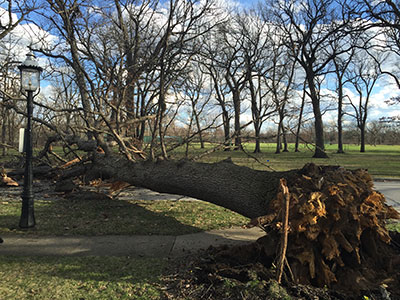Although I have a sad story about the end of a tree, it is also a story of how that tree continues to contribute to the Riverside community and has connected people who share a passion for our planet and its resources. In a way, it's a story about a new beginning.
I am a forester for the Village of Riverside. On the day before St. Patrick's Day in 2015, we were experiencing high wind gusts, up to 50 mph. I received a call from our police dispatch center regarding a large tree blocking a roadway. Upon arrival, I saw a massive white oak, 32 inches in diameter, which had failed in the high winds due to armillaria root rot.
While I worked to clear the road, I began to think about the potential of the fallen tree. As I made cuts, I formed a goal of saving the tree trunk for a higher purpose.
Once we had finished clearing the road, we placed the 16-foot-long log in a nearby park. The next day, I began to count the annual rings in the log to determine the age of the tree. It was over 150 years old! It was a presettlement oak tree that had been a sapling when Frederick Law Olmsted walked our river banks and designed our landscape.
For those who are not familiar with Riverside, it is a historic community, designed by Olmsted and Clavert Vaux in the 1870s. Olmsted is considered to be the father of landscape architecture in the United States and created Central Park in New York City as well as many other American landscape treasures. The roadway plan of Riverside is a curvilinear masterpiece, designed to mirror the ebbs and flows of the Des Plaines river.
Realizing that historical connection set me on course to repurpose the old white oak and allow it to live on as a testament to Riverside and its creator.
I received enthuisastic support for the project from the public works director, Ed Bailey; the village manager, Jessica Frances; and the village president, Benjamin Sells. As a forester, I have always enjoyed a level of support that is second to none! The Riverside community and its elected officials have always placed a high value on its landscape and shared a vision for green initiatives.
The seed of the idea of urban wood utilization had been planted in my mind several years earlier by Edith Makra, then Community Trees Program Coordinator at The Morton Arboretum. A few years back, I had made a connection with Dan DeSerto at Bull Valley Hardwood, a sawmill and wood working shop in Woodstock, Ill., to utilize some ash logs harvested from a woodland area.
Dan shared my vision for repurposing the old oak and worked with me to process the log. He also put me in touch with Paul J. Meyer of Woodstock Woodworks and Studio. Paul designed and crafted three white oak boardroom tables from the log, incorporating more than 100 pieces of wood per pedestal. They are real works of art that will live on in Riverside for many years to come!
Both Dan and Paul donated significant amounts of time to make this project a reality. I also made some new friends along the way as I learned from Dan and Paul. I always knew trees could be harvested for furniture, but I had no idea about the process.
So many people came together for this project and it was an honor to work with each and every one of them. I owe this tree a debt of gratitude for all the connections I made as the project became greater than the sum of its parts.
I had always marveled at the many white oaks in this area of town and, as a forester, I have a deep appreciation for old trees. They have a special place in all of our hearts. These trees have taken on a new meaning to me now.




